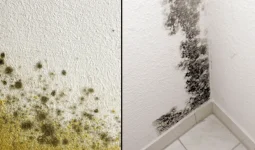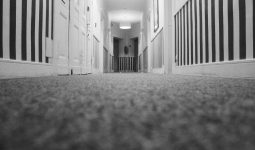Wall texture is commonly used to finish interior wall surfaces and beautify and enhance any interior aesthetic in your home.
The styles are significantly different; most homes we walk into now have many textures on their film rock wall.
However, every wall texture adds importance and interest to your interior.
So, if you’re a bit confused about the type of textured wall to choose, we have discussed eight types of wall textures and what makes each unique.
Keep reading!
1. Orange Peel Texture
Orange peel texture is a famous wall texture, and people also refer to it as “splatter” or “eggshell.”
It looks like orange oil sacs and gives the wall surface an attractive and smooth look. It also makes the wall look decent and neat, and it is also affordable.
Also, this wall texture transforms flat walls into finishes that reproduce light and add interest to a house.
It has a cracked and subtly wrinkled surface and is reminiscent of an orange.
You can paint over the wall with white paint to create a more natural look.
Furthermore, its popularity is due to its ability to hide imperfections. It can also help to comprehend sound between walls and floors.
2. Slap Brush Texture
Slap brush texture or stomp brush, is another type of wall texture. It creates a random line on your wall and adds an eccentric flair to any home.
Also, it has many patterns, with brushes pushed up against the mud after being applied to the wall.
There are many ways to use the piece of drywall compound and create the slap brush effect. However, here’s the most famous method:
First, pour a small amount of the thinned compound into a paint pan. Use the paint roller to apply a thick compound layer to the wall.
Then, use the brush to create a stippled effect on the wall, holding the brush tight to the wall.
Afterward, press it straight to the wet compound and remove it. However, the slap brush takes 24 hours before it will dry.
3. Popcorn Texture
Another name for popcorn texture paint is sprayed acoustic texture, and it’s also one of the different types of wall textures.
Painters apply it to the walls and ceilings with a drywall or plaster texture sprayer.
If you love popcorn, you will enjoy using this wall texture, which gives your room a unique look.
You can use this wall texture to decorate your kitchen, dining area, or bathroom.
However, avoid applying too much pressure when painting the wall. Otherwise, you might ruin the surface.
Popcorn ceilings and walls in your home can help increase its value. A popcorn-textured wall can do the trick if you want to sell your home and make it more attractive.
4. Comb Texture
Comb texture is also among the different wall texture types. You can get this texture using methods that create various widths and shapes in either vertical or horizontal lines in drywall.
So, it makes a repeated series of lines, rainbow shapes, or patterns on the wall.
You can use this texture to decorate your living room, bedroom, or entire wall.
However, it would help if you were careful not to apply too much pressure while applying the wall texture. Otherwise, you might damage the surface.
This texture is the most uncomplicated texture to apply to the drywall compound.
You can use a roller on the wall surface and then rob it on the wall with the “teeth” end of a toothed trowel.
However, it depends on your preferred pattern, evenly or unevenly spaced teeth.
If you have given it a smooth finish, expect the end product to create a sweeping, circular rainbow pattern.
5. Sand Swirl Texture
Sand swirl texture paint is also among the different types of wall textures.
You can get this texture type by mixing your color choice, stain, or sand, and it’s a great way to create a rustic feel in your house.
You can also use this wall texture style to decorate your house’s exterior.
If you decide to cover the whole wall surface with a sand swirl texture, you’ll make no mistakes.
However, you should avoid applying too much pressure when doing so, as this might damage the surface.
The best thing about this type of texture is that it will last years without fading. Its matte finish makes it look like stone.
This will be perfect for you if you want to make your walls look natural.
Since the sand swirl texture contains nothing but sand, it needs a proper drywall texture technique. This texture is applied to the drywall with a textured brush.
6. Knockdown Texture
Knockdown texture paint is also among the different wall textures, a drywall successor to popcorn and orange peel textures.
It has remained a hit with homeowners for its impressive appearance and suitability.
However, there are three main types of knockdown textures which are :
- Splatter
- Stomp
- Mud trowel
Each has a specific look and requires unique tools and techniques. But the most popular knockdown texture is “Splatter,” which has the classic look of Spanish lace stucco.
Knockdown makes the home more suitable and neat, increasing its value. Sponges, stencils, and clean trowels are different ways to generate this texture on your walls.
7. Smooth Texture
If you want to give your walls a smooth texture, try painting them with smooth wall paint. A smooth wall texture can create a sleek and modern look in any home.
Depending on the room’s paint color and other design elements, smooth wall textures can also create a more classic look.
They are easy to clean and maintain, making them a popular choice for busy families.
You’ll want to use a roller or brush to apply an even layer of paint to your walls for a smooth wall texture. Make sure to go over any areas that seem rough or uneven.
Once you’ve achieved a smooth finish, you should have an excellent surface that looks great and is easy to clean.
8. Coconut Shells Texture
Coconut shells are versatile materials useful for several purposes, including creating wall textures.
When used as a wall texture, they add a natural, organic look to any space.
Coconut shells can be used whole or cut into smaller pieces to create a mosaic. They are also excellent for wall texture because they are durable and easy to clean.
The texture of the coconut shells is quite simple. You must remove the coconut shells and place them on the wall.
People use them to decorate kitchens and bathrooms with consistent or random patterns.
You would love the outcome if you tried it, too; however, it would be best to be careful when applying the wall texture.
Don’t press down too hard; otherwise, the surface might get affected.
Conclusion
These different wall textures would give your home a unique and decent look. However, you can only try one at a time.
Did we miss out on anything? Let us know in the comments section below. Thanks for reading!








